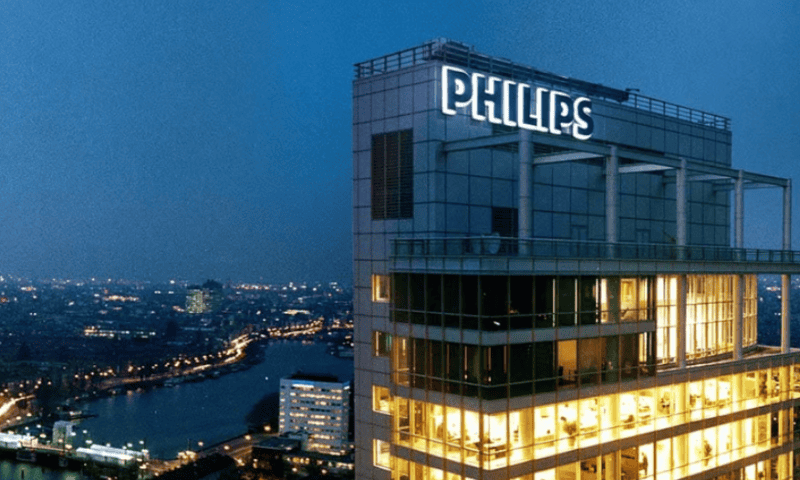The second quarter of this year marked the first time in over a year that Philips reported a positive net income, and—for now, at least—it’s staying there.
For the three-month period ending Sept. 30, Philips calculated a net profit of 90 million euros ($95 million U.S.), a vast improvement compared to a year prior, when the company reported a net loss of more than 1.3 billion euros. It also represents steady quarter-by-quarter growth: Philips’ second-quarter profit weighed in at 74 million euros.
The Dutch conglomerate was able to stay in the black despite having to shell out 162 million euros for restructuring, acquisition-related and other charges, which include the costs of this quarter’s chunk of Philips’ planned workforce reduction and of the ongoing remediation program for its recall of 5.5 million respiratory devices.
In its third-quarter earnings report Monday, the company attributed the positive net income in part to steadily growing revenues: It raked in nearly 4.5 billion euros in sales for the quarter, up about 4% from last year in terms of nominal sales growth and 11% on a comparable basis. The vast year-over-year profit improvement was also helped along by the fact that Philips had taken a 1.5-billion-euro goodwill and R&D impairment charge in the third quarter of 2022.
Those wins on the earnings sheet led the company to boost its expectations for the full year, with it now expecting 2023’s comparable sales growth to clock in between 6% and 7%, up from the “mid-single-digit” growth it was expecting a quarter ago.
Despite those growing sales and profits, however, Philips saw its order book continue to shrink. Order intake dropped 9% year-over-year, echoing last quarter’s results, when the devicemaker reported an 8% decrease in new orders.
During a call with investors on Monday, CEO Roy Jakobs linked the decline to higher-than-normal numbers in 2021 and 2022, as well as longer lead times between orders and deliveries, plus “substantially lower” order counts in China.
“We continue to see hospital healthcare systems in the U.S. and other mature geographies exhibit cautious buying behavior in the short term, and China is heavily impacted by the government-initiated anti-corruption measures,” he explained.
But the company is expecting to see its order growth creep back upward in the coming quarters as it tweaks its operating model, introduces new products and works to reduce lead times, according to Jakobs.
“On Q4, we have said it’s going to be a significant improvement on the minus 9%. Now, whether that is going to be negative or positive, given all the uncertainties, we are not speculating on that at the moment, but it will be a substantial improvement on the minus 9% that we had in Q3,” Abhijit Bhattacharya, Philips’ CFO, assured investors on the call.
Jakobs and his fellow executives also devoted much of Monday’s call to discussing the actions Philips is taking with regard to the ongoing respiratory recall.
To date, Philips has completed remediation of more than 99% of affected CPAP and BiPAP machines with complete and actionable registrations in the repair-and-replace program, while remediation of the ventilators included in the recall is still ongoing, per Jakobs.
Meanwhile, in the wake of the FDA’s disclosure earlier this month that it “remains unsatisfied” with the status of the recall and has requested that Philips perform additional tests of the disintegrating polyester-based polyurethane (PE-PUR) foam that sparked the safety event—after previous Philips-commissioned studies concluded that the foam “is unlikely to result in an appreciable harm to health in patients”—Jakobs said the company has been in discussions with the agency over what, exactly, the new tests will entail.
“I think what’s important is that the FDA did not disqualify our testing to date,” he noted. “The fact that they have some additional questions to be answered, actually, I see as very positive, because if we can satisfy those, we can come to the same conclusions hopefully.”
He continued, “We will do that in full collaboration, and we also see this as a positive development because the clearer we can get on what is still outstanding to be answered, that helps us to take those questions off the table, and we of course remain at full disposal to do so.”
Though the company was unable to provide any concrete updates on the FDA’s proposed consent decree—which is separate from the testing request—nor on the ongoing litigation investigation by the U.S. Department of Justice, Jakobs confirmed that Philips is in “continuous dialogue” with the FDA over the former and Bhattacharya promised to release details of the consent decree and its impact on Philips “as soon as the CD is signed and it’s done.”
On a patient level, this month ushered in preliminary court approval for the first settlement in the wide-ranging class-action lawsuit over the recall, in which Philips agreed to resolve all eligible economic loss claims in the suit. To do so, it’ll dip into the 575 million euros it set aside in the first quarter of this year for just that purpose.
In the meantime, the company is still facing additional swaths of personal injury and wrongful death claims and medical monitoring requests filed in the lawsuit. On Monday’s call, Bhattacharya said Philips is tentatively expecting to be able to report a dollar amount for the medical injury claims in the second half of next year, while Jakobs added that the medical monitoring litigation is “progressing as we expected,” with an update potentially to come in 2024.
As for the total size of the class-action case, Jakobs told investors that 54,000 people have so far joined the designated census registry, but “only 670 currently are in the process with a lawyer in terms of claiming anything.”

